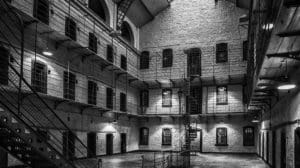Chernobyl: The True Story Behind the HBO Series Filming Locations

Updated On: March 31, 2024 by Raghda Elsabbagh
The HBO series Chernobyl has captivated audiences with its gripping portrayal of the catastrophic nuclear disaster that occurred in 1986. As we dive into the narrative, it becomes evident that the true story is far more than just the recounting of events; it’s a complex mix of human error, bravery, and politics. The choice of filming locations was vital in bringing authenticity to the miniseries, with the Lithuanian city of Visaginas playing a crucial role due to its striking resemblance to the actual site of the Chernobyl power plant.

The series not only revisits the disaster itself but also endeavours to depict the human experiences and the widespread impact of the tragedy. Through its cinematic storytelling, Chernobyl explores the scientific explanations, environmental effects, and the response to the disaster, shedding light on the powerful stories of those who were affected. It offers a harrowing look at the events, juxtaposed with the political and social climate of the time, making it a compelling drama that resonates with a sense of historical gravitas.
Historical Context of Chernobyl
In the twilight years of the Soviet Union, the Chernobyl Nuclear Power Plant exemplified the nation’s fervour to claim dominance in nuclear energy. However, beneath the surface of progress, the seeds of disaster were being sown.
Soviet Union’s Nuclear Ambitions
The Soviet Union’s quest for nuclear prowess was a keystone of their scientific and military policy. They envisioned nuclear power as a pathway to energy independence and global supremacy. In this vein, Chernobyl was established, reflecting the ambition of its creators and the stark reality of its eventual tragedy. By the time of the accident in 1986, the plant was home to four reactors with the capacity to expand further.
- Location: Northern Ukraine, near the city of Pripyat
- Purpose: Generation of electricity and manifestation of the Soviet Union’s technological advancement
- Outcome: The worst nuclear disaster in history, which exposed the flaws in the Soviet nuclear industry
The City of Pripyat
Founded in 1970 to house the plant’s workers and their families, Pripyat was the model Soviet city. With a population of nearly 50,000 residents at the time of the accident, it was a symbol of Soviet urban planning—equipped with all the amenities expected of a thriving city and then some.
- Founded: 1970
- Population Pre-Accident: Approx. 49,000
- Facilities: Amusement park, sports complex, cinema, and hospital
Tragically, Pripyat became a ghost town overnight, as the entire city was evacuated in the aftermath of the Chernobyl disaster. It remains uninhabited, standing as an eerie testament to the disaster’s magnitude.
The Chernobyl Disaster Unfolds
As we delve into the events of the Chernobyl disaster, it is crucial to comprehend the severity of the accident that unfolded at the power plant, the immediate response by the emergency services, and the eventual evacuation of the nearby city of Pripyat.
The Explosion
On 26 April 1986, Reactor 4 at the Chernobyl Nuclear Power Plant experienced a catastrophic explosion during a safety test. The blast and subsequent fire released large quantities of radioactive particles into the atmosphere.
Immediate Aftermath
In the immediate aftermath of the explosion, firefighters were dispatched to tackle the inferno, unaware of the extreme radiation levels. Their brave efforts were critical in the immediate response to the accident but tragically resulted in severe radiation exposure.
Evacuation of Pripyat
The evacuation of Pripyat commenced on 27 April, over a day after the explosion. Residents were given little information about the severity of the disaster, merely told it was a precautionary measure. The death toll from the disaster is still disputed, but it is acknowledged that the immediate and longer-term effects have caused numerous deaths and diseases.
Portrayal of Key Figures

In the HBO series Chernobyl, the characters embody the moments of crisis and exemplify the varied responses to the catastrophe. This dramatic retelling emphasises both the heroism and the complexity of those involved in the disaster’s immediate aftermath and subsequent management.
Valery Legasov and Ulana Khomyuk
Valery Legasov, as portrayed by Jared Harris, serves as the representation of the scientific community grappling with the magnitude of the disaster. The character draws from the real-life Legasov’s efforts to contain the fallout of the event. Ulana Khomyuk, embodied by Emily Watson, is a composite character created for the series and represents the collective efforts of the scientific community to uncover the truth behind the reactor’s explosion.
- Valery Legasov:
- Scientist
- Played by Jared Harris
- Ulana Khomyuk:
- Composite Character
- Portrayed by Emily Watson
First Responders and Firefighters
The depiction of first responders and firefighters, including Vasily Ignatenko and his wife Lyudmilla Ignatenko, draws heavily on the personal sacrifices and the dire immediacy of their response. The series brings to the forefront their bravery in facing an invisible enemy and the devastating impact on their lives that followed, offering viewers insight into both the heroism and human cost.
- First Responders/Firefighters:
- Bravery and Sacrifice
- Vasily Ignatenko:
- Firefighter
- Lyudmilla Ignatenko:
- Vasily’s Wife
Soviet Government Officials
Within the series, Boris Shcherbina is vividly depicted in his journey from government scepticism to facing the harsh truths of the disaster. As portrayed by the seasoned actor Stellan Skarsgård, Shcherbina’s character experiences a transformation in response to the scale of the Chernobyl catastrophe. The inclusion of Mikhail Gorbachev illustrates the high-level political struggles and the complexities of the Soviet government’s response. Notably, Anatoly Dyatlov is presented as a contentious figure, his actions and attitude within the control room forming a central flashpoint in the narrative.
- Boris Shcherbina:
- Government Official
- Transformation and Response
- Played by Stellan Skarsgård
- Mikhail Gorbachev:
- Soviet Leader
- Political Struggles
- Anatoly Dyatlov:
- Deputy Chief Engineer
- Central Flashpoint in Narrative
Scientific Explanation

Our exploration into the scientific aspects of the Chernobyl disaster reveals significant insights into the nuclear reactor design flaws and the intricate details of Chernobyl’s RBMK reactor analysis. These elements played critical roles in the events leading up to and following the catastrophic accident.
Nuclear Reactor Design Flaws
The Chernobyl incident brought to light severe design flaws in the Soviet-era RBMK nuclear reactors. Experts from the Kurchatov Institute of Atomic Energy and scientists globally scrutinised the RBMK design post-disaster, identifying a number of critical deficiencies. One such flaw was the reactor’s positive void coefficient, where an increase in steam production could escalate the reactor power output dangerously. Additionally, the control rods, designed to stabilise reactor power levels, had tips that initially displaced coolant and briefly increased the reactivity in certain parts of the reactor core during an emergency shutdown.
Chernobyl’s RBMK Reactor Analysis
Analysing Reactor 4, the specific site of the Chernobyl disaster, it becomes apparent that a combination of inherent problems within the RBMK design exacerbated the chain of events on that fateful day. It lacked a robust, contained structure, rendering the system highly susceptible to both human error and internal reactor conditions. The catastrophe highlighted the RBMK reactors’ inability to safely manage the Problems associated with large-scale nuclear fission and high power output, ultimately sparking significant redesigns and safety measures within the nuclear power industry.
Health and Environmental Impact

In the wake of the Chernobyl disaster, the health and environmental repercussions have become defining elements of the tragedy. We examine the acute crisis faced by individuals directly after the incident, delve into the enduring health consequences, and explore the regenerative capacity of nature in the absence of human presence.
Acute Radiation Syndrome
The immediate aftermath of the Chernobyl explosion saw workers and first responders stricken with Acute Radiation Syndrome (ARS), a condition caused by high-dose radiation exposure. Symptoms of ARS emerged within hours, and as reported by the World Health Organisation, many of these individuals succumbed to the syndrome, denoting the first of the disaster’s numerous casualties.
Long-term Health Effects
The long-term health effects following the Chernobyl incident have been pervasive, with Thyroid Cancer cases surging, particularly among children who were exposed to radioactive iodine. Investigations by organisations like Greenpeace have highlighted an increase in other health issues, including Birth Defects, which sadly, yet unequivocally, point to the catastrophic human cost over the years.
Exclusion Zone and Wildlife
Marked by a 19-mile radius, the Exclusion Zone remains a stark reminder of Chernobyl’s lasting impact. Remarkably, within this area, flora and fauna have displayed resilience and, in the absence of human disturbance, thrived. Reports indicate a resurgence of wildlife populations, suggesting that nature, in some respects, is adapting to life amidst the contamination.
The Disaster Response

In the wake of the Chernobyl nuclear accident, a massive and multi-tiered emergency operation was mounted by Soviet authorities to contain the catastrophe and limit its impact on the population and environment.
Soviet Crisis Management
The Soviet government launched a large-scale crisis management effort immediately after the explosion at Chernobyl. Officials drafted a plan that involved a range of measures, from evacuating civilians to attempting to limit the spread of radioactive materials. The rapid evacuation of the local population from the exclusion zone, including the city of Pripyat, was carried out to protect them from high levels of radiation. Despite these efforts, the information regarding the severity of the disaster was initially kept secret from both the Soviet public and the international community, which delayed additional aid and specialised resources.
Role of the Liquidators
The term “Liquidators” refers to the civilian and military personnel—which included doctors, engineers, miners, and so forth—who were given the task of dealing with the consequences of the Chernobyl disaster. These individuals faced extreme conditions and high radiation doses during operations like removing hazardous debris by hand, a task for which some individuals were later referred to as “biorobots.” The cleanup efforts spanned several years, with liquidators constructing the sarcophagus— a concrete structure built to contain the radiation and prevent further release into the atmosphere. Over 600,000 liquidators were ultimately involved, many of whom suffered health complications as a result of their exposure to radiation.
Cultural Depiction of Chernobyl
Chernobyl‘s harrowing tale has been encapsulated by HBO’s gripping TV show, which offers a dramatised portrayal of the disaster and its aftermath.
Creating the HBO Series
Craig Mazin masterfully crafted Chernobyl, a poignant miniseries that reveals the complexities of the human spirit in the face of catastrophe. Starring the talented Jared Harris and Jessie Buckley, the series weaves personal stories with political drama to give viewers a multidimensional view of the event that shook the world.
Filming Locations
Major parts of the Chernobyl series were filmed in Lithuania, standing in for the Exclusion Zone and the ill-fated Pripyat. The country’s Soviet-era architecture provided an authentic backdrop, transporting viewers to 1986 Ukraine with an impressive degree of accuracy.
Public and Critical Reception

The HBO series Chernobyl has generated significant attention both from the viewers and critics alike, reflecting in its high viewer ratings and numerous awards and nominations.
Viewer Ratings
According to IMDb, Chernobyl has received overwhelming acclaim, boasting a high score that stands testament to the mini-series’ gripping storytelling and historical accuracy. The series rapidly amassed a substantial viewership, and discussions about its content proliferated across various platforms, underpinning its popularity.
Awards and Nominations
Chernobyl distinguished itself on the awards circuit, securing a remarkable tally of accolades. The series was recognised at major awards ceremonies, including:
- BAFTAs: Chernobyl secured several nominations and was awarded for its exceptional craft in storytelling.
- Golden Globes: Its gripping narrative and cinematic excellence didn’t go unnoticed, bringing home top honours.
- Emmys: The mini-series received significant recognition, with numerous nominations and wins across various categories.
Critics from reputable sources like the BBC praised the series for its meticulous attention to detail and its raw, unflinching portrayal of events. Commendations by critics across the globe solidified Chernobyl’s standing as a critically-acclaimed representation of the tragic event.
Myths Vs. Reality
As we explore the Chernobyl HBO series, it’s crucial we distinguish between dramatisation for narrative effect and what actually transpired during the Chernobyl disaster. We’ll examine how certain elements were portrayed and what that means for our understanding of the events.
The Drama vs. Historical Accuracy
The HBO series, while gripping, has naturally taken some artistic liberties to craft a coherent and engaging narrative. The show has been largely acclaimed for its attention to detail and accurate depiction of the Chernobyl disaster’s atmosphere. Yet, some aspects, like the visual representation of radiation as a pervasive, glowing presence, have been criticised for possible exaggeration. However, it serves as a powerful tool to convey the invisible threat of radiation to viewers.
Fictional Characters and Events
In the storytelling process, several characters and events have been fictionalised to represent broader truths. For instance, Ulana Khomyuk is a composite character, symbolising the many scientists who worked tirelessly to resolve the crisis. This approach, while not strictly factual, embodies the collective efforts of unsung heroes. Additionally, the series drew inspiration from the accounts of Svetlana Alexievich, a Nobel laureate who collected testimonies from those affected by Chernobyl, though the characters you see on screen may not be direct representations of real individuals.
The HBO series has kindled a renewed interest in the realities of the Chernobyl disaster, merging fiction with the stark truths of history. Its impact is a reminder of the power of storytelling in shaping our collective memory.
The Legacy of Chernobyl
Before delving into the specific impacts of the Chernobyl disaster, it’s imperative to recognise its far-reaching effects on global nuclear safety and the unexpected establishment of a tourism sector, both of which continue to resonate today.
Global Nuclear Safety
The Chernobyl incident marked a pivotal moment for nuclear power safety worldwide. In the immediate aftermath, the United Nations (UN) and European countries re-evaluated the nuclear safety standards that were in place. Notably, the disaster was a direct result of a flawed Soviet reactor and an inadequately planned safety test. In response, the disaster has been instrumental in defining how nuclear plants across the globe handle safety protocols to prevent similar incidents.
A tangible example of improved safety is the construction of the Chernobyl Sarcophagus, a massive steel and concrete structure designed to contain radioactive materials within the destroyed reactor. This innovation represents a remarkable engineering feat and serves as a symbol of the commitment to make nuclear energy safer.
Chernobyl Tourism
Chernobyl’s legacy has also paradoxically included the rise of the tourism industry. Visitors from around Europe and the rest of the world travel to the site of the worst nuclear disaster in history, turning it into a unique tourist destination. Guided tours offer insights into the aftermath and impact of the catastrophe, coupled with safety measures to protect tourists from radiation exposure.
The site and the deserted city of Pripyat are attracting increasing numbers of tourists, drawn by the historical significance and the stark reminder of the past. While this might seem contentious to some, the influx of tourism has played a role in educating the public on the consequences of the disaster and the importance of nuclear safety.
Frequently Asked Questions

In uncovering the true story behind the locations of the HBO series Chernobyl, we’ve compiled a list of the most commonly asked questions. These delve into filming locations, historical accuracy, the use of actual footage, character representations, and the impact of the series in understanding the disaster.
What locations were used by HBO to film the Chernobyl series?
The HBO series Chernobyl was primarily filmed in Lithuania, with the city of Vilnius and its disused power plant standing in for the scenes at the Chernobyl plant. Key areas within Ukraine were also used to add authenticity to the settings.
How closely does the HBO series Chernobyl adhere to the historical events?
The Chernobyl series is noted for its dedication to historical accuracy, capturing the essence of the disaster and its aftermath with attention to detail. However, some dramatic licenses were taken to enhance the narrative flow and character development.
Did the Chernobyl HBO series incorporate any actual footage from the disaster?
No actual footage from the 1986 disaster was used in the series. Instead, the production team recreated scenes meticulously to portray the events faithfully without utilising documentary footage.
Are the character portrayals in the HBO Chernobyl series based on real individuals?
Many characters in the series are based on real people involved in the disaster, including Soviet scientist Valery Legasov and deputy chief engineer Anatoly Dyatlov. Other characters were amalgamations or fictional, created to represent the experiences of those affected by the tragedy.
What discoveries were made about the Chernobyl disaster through the release of the HBO series?
The release of the HBO series brought renewed attention to the Chernobyl disaster, highlighting aspects such as the Soviet government’s response and the extent of sacrifices made by first responders. It sparked discussions and brought forth new information about the event’s impact.
In what ways does the HBO series Chernobyl differ from the original accounts of the event?
While Chernobyl is largely accurate, some deviations include the portrayal of certain events for dramatic purposes and the condensation of the timeline. Nevertheless, the series strived to remain faithful to the overall storyline of the actual events.






